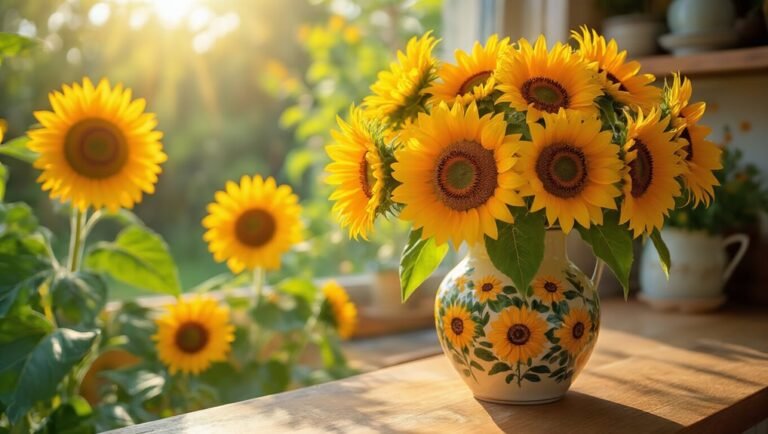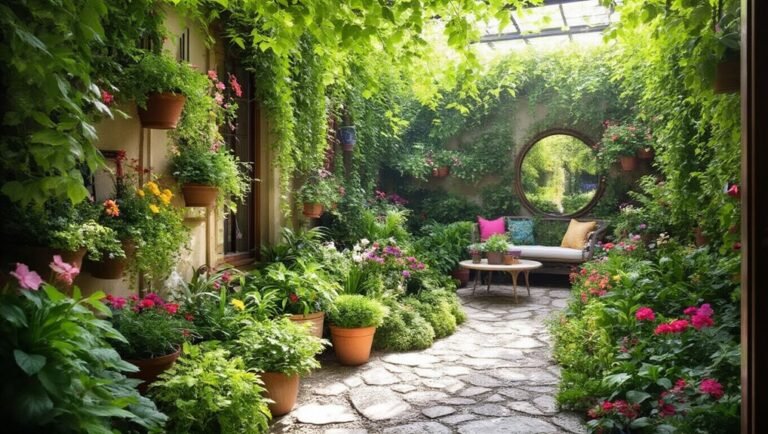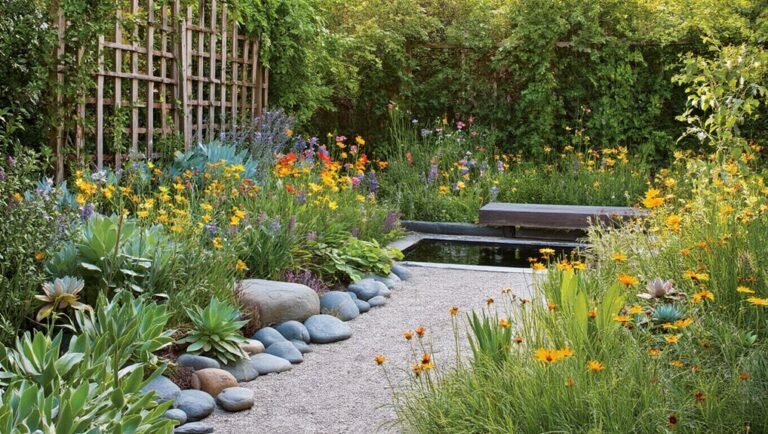If you’re looking to brighten your garden, consider planting blue flowers like Delphinium, Bluebell, and Hydrangea for stunning visual appeal. Lobelia and Forget-Me-Not add charm and attract pollinators. Don’t overlook Aconitum (Monkshood) and Cornflower, which complement other plant varieties beautifully. For hardy options, Salvia and Brunnera (False Forget-Me-Not) thrive in various conditions and provide vibrant colors. Explore these choices to enhance your outdoor space and discover even more options for a spectacular garden.
Key Takeaways
- Delphinium: Tall spikes of vibrant blue flowers that thrive in full sun and attract butterflies, ideal for the back of flower beds.
- Bluebell: Charming perennials that bloom in spring, creating a beautiful blue carpet in partially shaded areas.
- Hydrangea: Known for large, showy blooms; various types thrive in partial shade and can be enhanced for blue hues.
- Lobelia: Offers vibrant blue flowers perfect for containers and hanging baskets, attracting pollinators and creating cascading effects.
- Forget-Me-Not: Delicate blue blooms that thrive in moist, well-drained soil, perfect for creating a spring carpet and attracting bees.
Delphinium
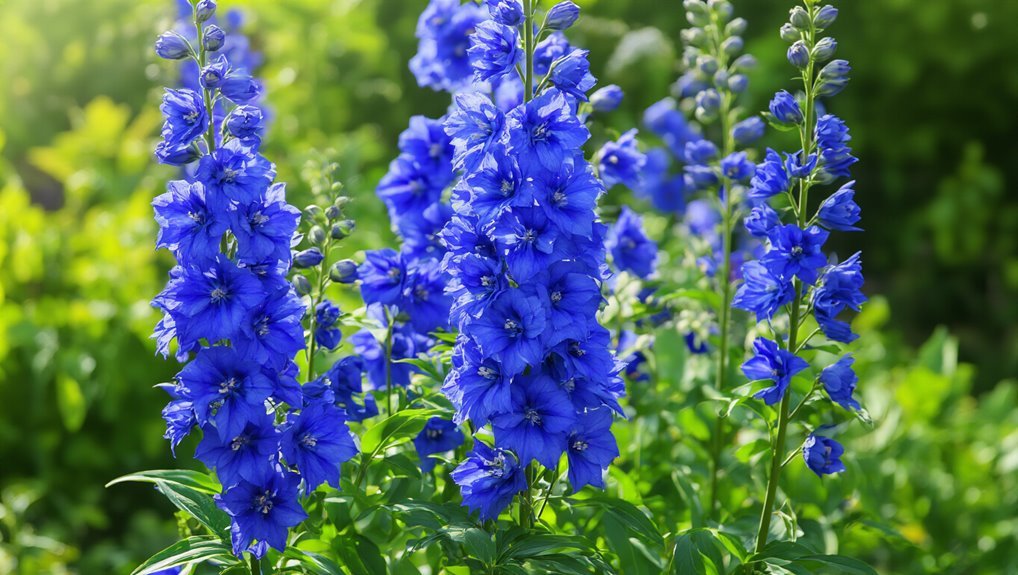
If you’re looking to add a burst of blue to your garden, delphiniums are a fantastic choice. These striking perennials boast tall spikes adorned with vibrant blue flowers, creating a stunning focal point.
Delphiniums thrive in full sun and prefer well-drained soil, making them easy to grow with the right conditions. They can reach heights of up to six feet, so plant them towards the back of your flower beds for maximum impact. For those interested in starting new plants, consider displaying your cuttings in a plant propagation station to encourage healthy root growth.
Regular watering and deadheading will keep them blooming beautifully throughout the summer. You’ll also appreciate their ability to attract butterflies and other pollinators.
If you want to get a head start on your delphiniums, consider using seed starting kits to help your seeds germinate indoors before transplanting them outside.
With a bit of care, your delphiniums will reward you with a breathtaking display year after year. Plant them and watch your garden come alive!
Bluebell
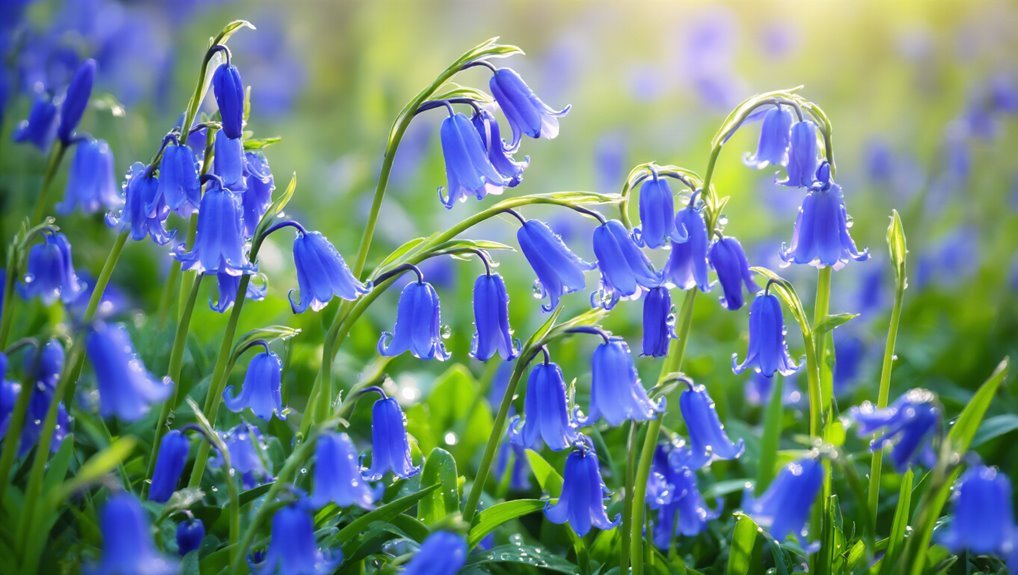
Bluebells are a charming addition to any garden, bringing a carpet of delicate blue blooms in spring.
These perennial favorites create a mesmerizing display, attracting bees and butterflies to your outdoor space. To further support their growth, consider using organic mulching materials like straw, which can enrich the soil and maintain optimal moisture levels.
When planting bluebells, consider these four tips to enhance their beauty:
- Location: Choose a partially shaded area with moist, well-drained soil to mimic their natural woodland habitat.
- Planting Time: Plant bulbs in the fall for vibrant blooms the following spring.
- Spacing: Space them about 10-15 cm apart to allow for their natural spread.
- Companions: Pair them with white or yellow flowers for a stunning contrast that highlights their blue hues.
For best results, consider adding a layer of mulch around your bluebells to help retain soil moisture and suppress weeds. With these tips, you’ll enjoy a breathtaking bluebell display each spring!
Hydrangea
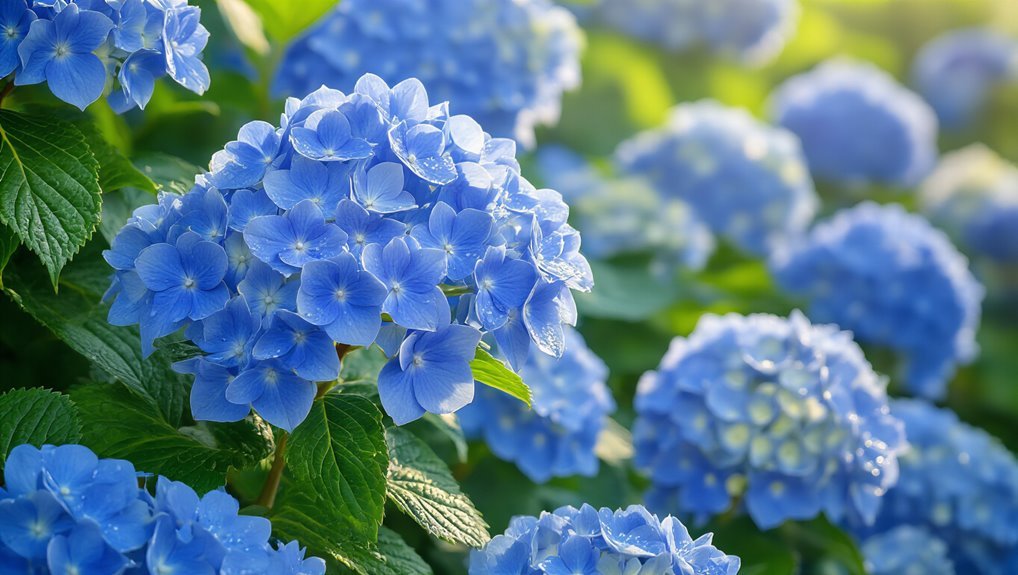
Hydrangeas are a stunning choice for any garden, known for their large, showy blooms that can transform your outdoor space. With their vibrant blue flowers, they add a touch of elegance and charm.
You’ll find various types, including the popular mophead and lacecap varieties, each offering unique beauty. Hydrangeas thrive in partial shade and well-drained soil, making them relatively easy to care for. For those looking to deepen their knowledge, exploring gardening books can provide additional tips and inspiration for cultivating healthy hydrangeas.
To encourage those brilliant blue hues, you might want to amend your soil with aluminum sulfate. Regular watering and occasional pruning will keep your plants healthy and promote lush growth.
Whether you’re looking for a focal point or a lovely backdrop, hydrangeas are sure to impress and bring life to your garden. For those interested in expanding their garden’s versatility, consider exploring Edible Flower Seeds for unique blooms that are both beautiful and culinary-friendly.
Lobelia
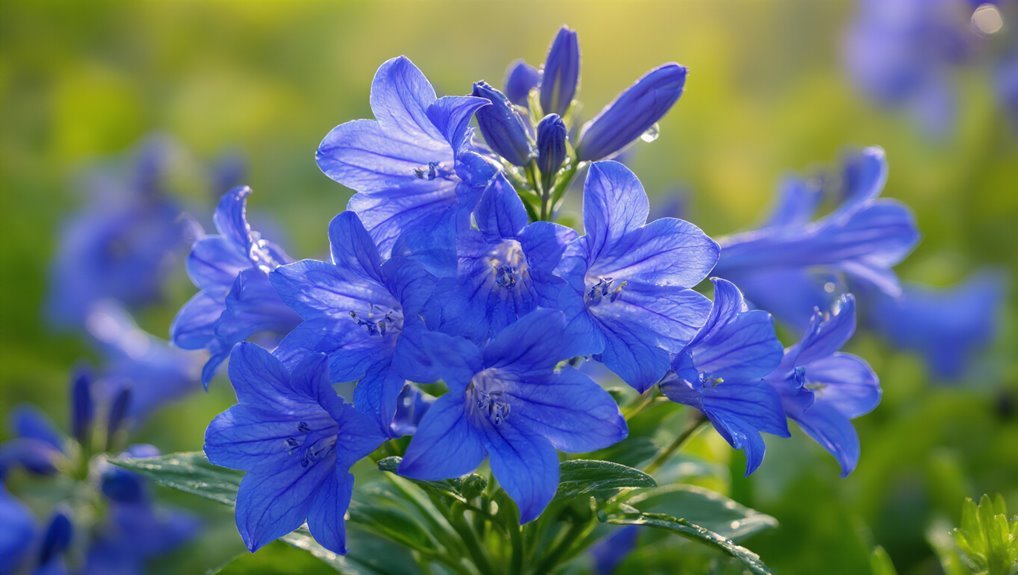
Lobelia is a charming addition to any garden, offering vibrant blue flowers that can brighten up your landscape. Its delicate blooms and trailing habit make it perfect for containers, hanging baskets, or as ground cover. If you’re interested in growing fresh herbs indoors, you might want to explore indoor herb gardens, which provide year-round greenery and flavor right in your kitchen.
You’ll love how lobelia attracts pollinators, bringing life to your outdoor space.
To create a stunning display, consider these ideas:
- Combine lobelia with white petunias for a crisp, fresh contrast.
- Pair it with yellow marigolds to create a cheerful, sunny vibe.
- Mix it with deep purple verbena for a striking color combination.
- Use lobelia along pathways to create a beautiful, cascading effect.
For those who love container gardening, you might also enjoy exploring Herb Garden Kits with Seeds and Pots, which can complement the beauty of lobelia in your outdoor or indoor spaces.
With lobelia, you can easily add a pop of color and charm to your garden!
Forget-Me-Not
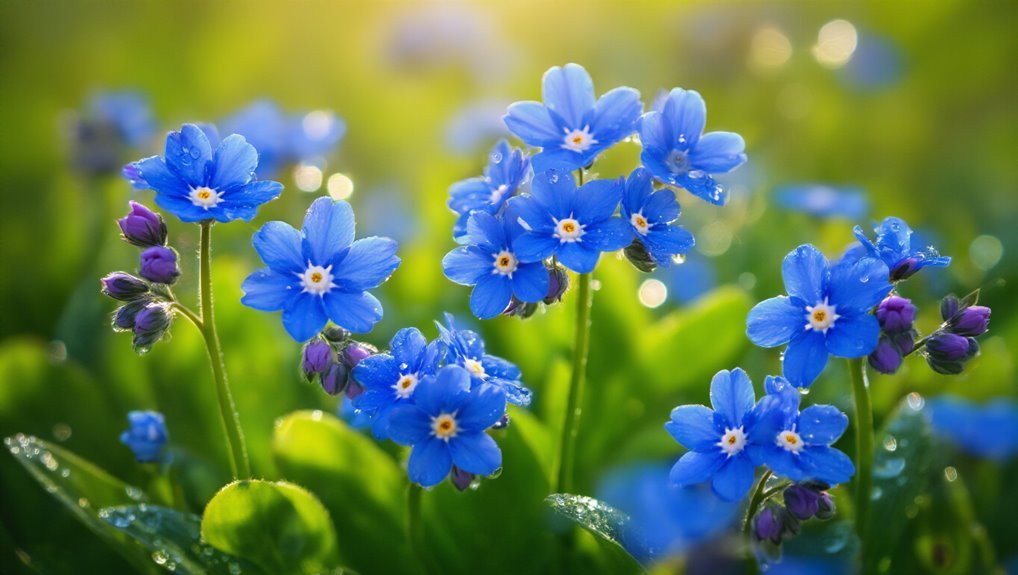
Forget-me-nots are enchanting little flowers that can transform any garden with their delicate blue blooms.
These charming perennials thrive in moist, well-drained soil and prefer partial shade, making them perfect for woodland gardens or borders. When you plant them, expect a carpet of vibrant blue in spring, attracting bees and butterflies to your yard. For gardeners, using the right gardening hand tools can make planting and caring for forget-me-nots much easier and more efficient.
They’re easy to grow and can self-seed, providing you with new plants year after year. To maintain their beauty, simply deadhead spent flowers and divide overcrowded clumps every few years.
You’ll love how forget-me-nots create a soft, romantic touch in any landscape. So, if you’re looking to add some color and nostalgia to your garden, don’t hesitate to include these lovely little blooms! For best results, consider using essential gardening tool sets to ensure proper planting and maintenance of your forget-me-nots.
Aconitum (Monkshood)
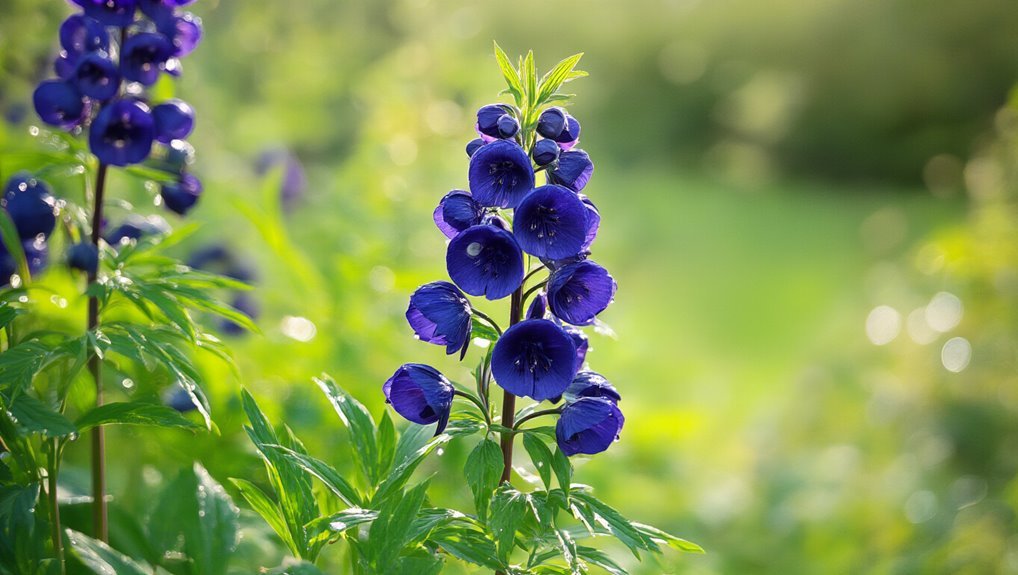
Aconitum, commonly known as monkshood, offers a striking addition to your garden with its tall spikes of deep blue or purple flowers. This perennial plant not only captivates but also thrives in partial shade and moist soil, making it an excellent choice for woodland gardens. For gardeners looking to shield their plants from unexpected cold snaps, consider using frost protection covers to help preserve delicate blooms like those of monkshood in cooler climates.
When you plant monkshood, envision the following:
- Elegant spikes reaching up to 5 feet, drawing the eye with their regal presence.
- Glossy, dark green leaves that provide a beautiful backdrop for the vibrant flowers.
- Long blooming period, typically from late summer to fall, ensuring your garden stays colorful.
- Unique helmet-shaped blooms that resemble the headgear of monks, adding an intriguing touch.
Just be cautious, as all parts of the plant are toxic if ingested. For gardeners interested in sustainability, using compost bins can help enrich the soil around your monkshood and other perennials.
Cornflower
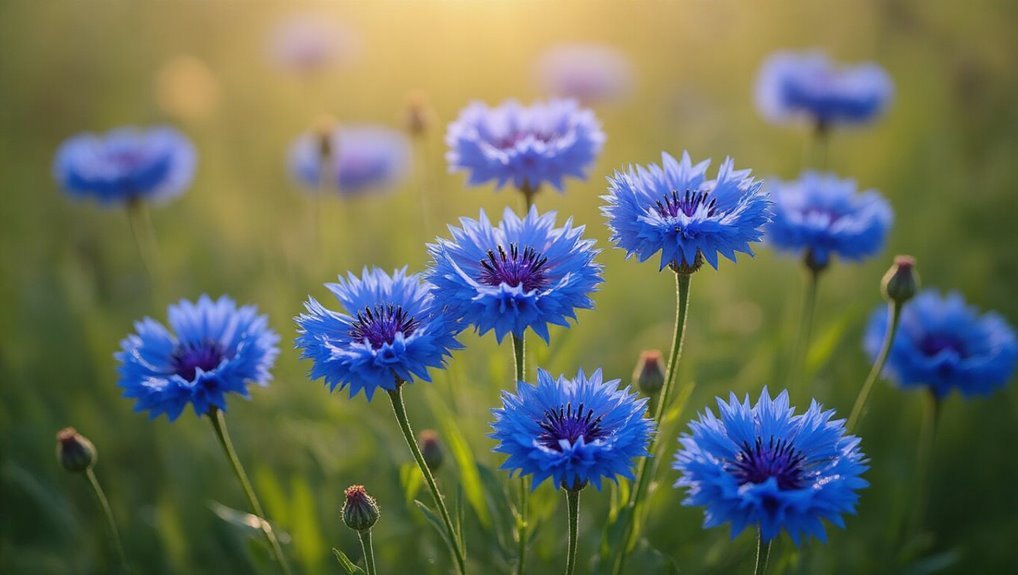
If you’re looking for a charming addition to your garden that complements the elegance of monkshood, consider cornflower.
These delightful blue blooms, also known as bachelor’s buttons, thrive in well-drained soil and full sun. Their vibrant color can brighten up borders, meadows, or even containers. For best results, support their growth with plant food to ensure they receive the nutrients they need throughout the season.
Plus, cornflowers attract beneficial pollinators like bees and butterflies, making them a great choice for eco-friendly gardeners. You’ll love how they self-seed, providing blooms year after year with little effort.
To maintain a tidy appearance, simply deadhead spent flowers.
Cornflowers come in various shades, from deep blue to soft lavender, allowing you to create stunning combinations in your garden.
Get ready to enjoy the beauty and charm of this classic flower!
For even healthier and more vibrant blooms, consider supplementing your garden with Plant Fertilizer Tablets, which can provide essential nutrients for optimal growth.
Salvia
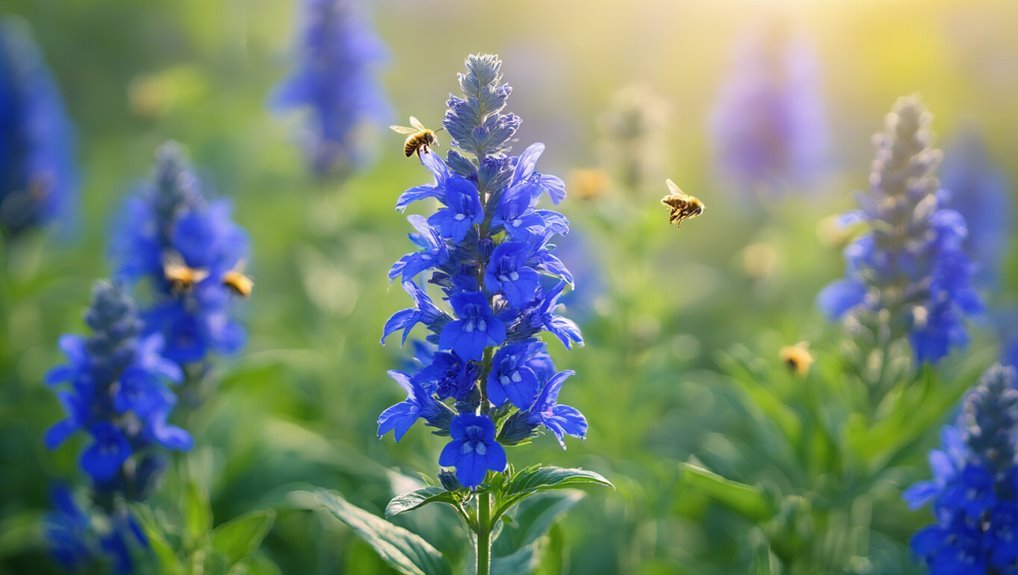
When you want to add a splash of vibrant blue to your garden, salvia is an excellent choice. This hardy perennial thrives in various conditions and attracts pollinators, making it a favorite among gardeners. For best results, planting salvia in quality garden soil will help ensure your plants grow strong and healthy.
Here are four stunning salvia varieties to consider:
- Salvia nemorosa – Known for its tall spikes of deep blue flowers that sway in the breeze.
- Salvia azurea – A striking plant with sky-blue blooms that can reach impressive heights.
- Salvia patens – Featuring large, trumpet-shaped flowers in a bright azure hue, perfect for borders.
- Salvia guaranitica – This variety showcases rich cobalt blue flowers, adding a tropical vibe to any garden.
If you’re starting your salvias from seed, using a seedling heat mat can help speed up germination and ensure strong, healthy growth. With salvia, you’ll create a stunning visual impact effortlessly!
Brunnera (False Forget-Me-Not)
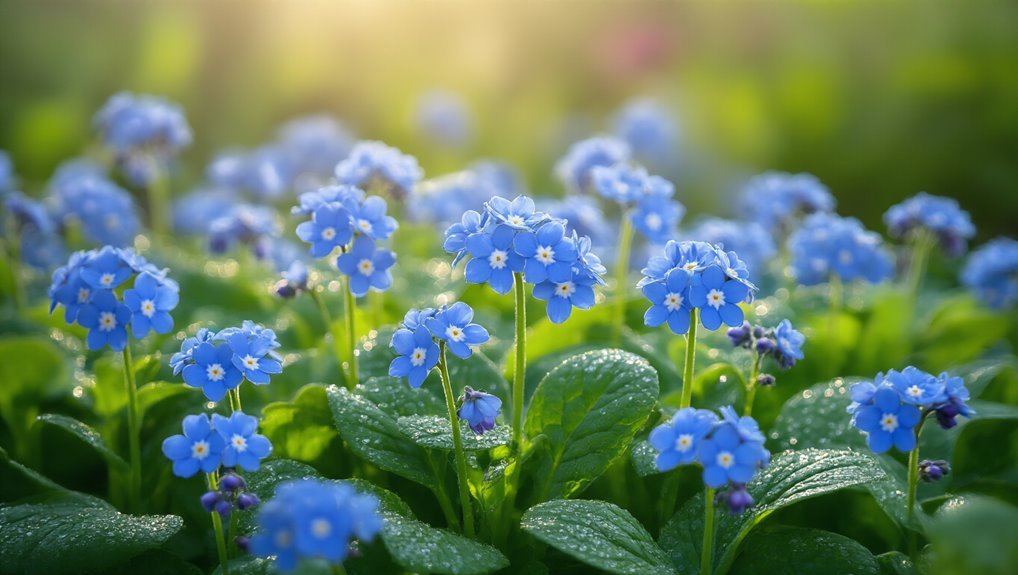
Brunnera, commonly known as False Forget-Me-Not, brings a charming touch of blue to shaded areas of your garden.
These perennial plants produce delicate clusters of small, vibrant blue flowers, often resembling those of true forget-me-nots. They thrive in moist, well-drained soil and prefer partial to full shade, making them perfect companions for hostas and ferns. You can highlight their beauty by displaying them in beautiful plant pots that complement their delicate blue blooms.
Brunnera’s heart-shaped leaves provide year-round interest, especially when they develop a striking silvery variegation. You’ll appreciate how they attract pollinators like bees and butterflies, enhancing your garden’s ecosystem.
Easy to grow and low maintenance, these beauties will spread gracefully over time, creating a stunning blue carpet beneath trees or shrubs.
Consider adding Brunnera to your shade garden for that extra pop of color!
For gardeners who enjoy caring for shade-loving perennials, you might also be interested in plant care kits designed for succulents and other specialty plants.
Frequently Asked Questions
What Is the Best Time to Plant Blue Flowers?
The best time to plant blue flowers is typically in spring or fall, depending on your climate. Make sure to check your local frost dates, so you can give your flowers the best chance to thrive.
How Do I Care for Blue Flowering Plants?
Caring for blue flowering plants is like nurturing a friendship; it requires attention and love. Water them regularly, ensure they get enough sunlight, and provide proper soil drainage to help them thrive and blossom beautifully.
Are Blue Flowers Deer-Resistant?
Not all blue flowers are deer-resistant, but some varieties tend to be less appealing to deer. It’s best to research specific plants and consider deer habits in your area when choosing your flowers.
Can Blue Flowers Grow in Shady Areas?
About 15% of flowering plants thrive in shady conditions. You can definitely grow blue flowers in shady areas. Just choose varieties that prefer low light, and you’ll enjoy beautiful blooms even in the shade.
Which Blue Flowers Attract Pollinators?
When choosing blue flowers that attract pollinators, consider plants like bluebells, hydrangeas, and lobelia. Their vibrant colors and sweet scents draw bees and butterflies, enhancing your garden’s beauty and supporting local ecosystems.
Conclusion
Planting blue flowers can transform your garden into a serene haven, reminiscent of Van Gogh’s starry nights. Whether you choose the towering delphinium or the delicate forget-me-not, each bloom adds a unique touch of tranquility. By incorporating these varieties, you’re not just cultivating plants; you’re creating a living canvas that echoes nature’s artistry. So, grab your gardening tools and let these stunning blue flowers weave their magic, turning your outdoor space into a dreamy retreat.
